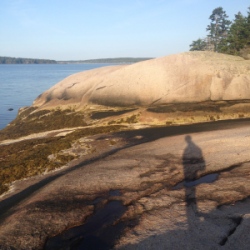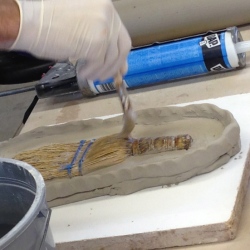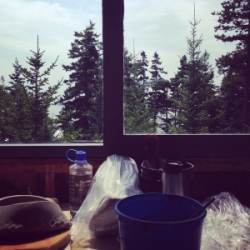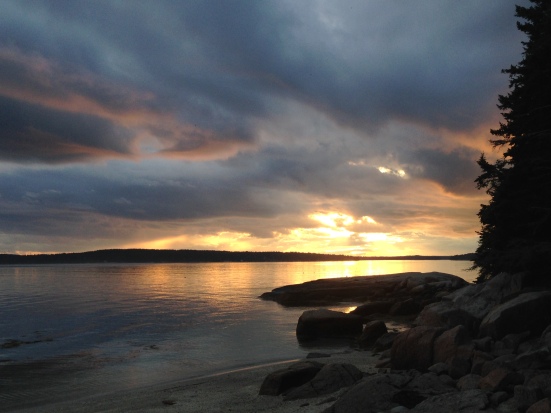This summer took me me from seven challenging weeks in Michigan through a few troubling days in Pennsylvania to an August perch on an island in Maine. Here I’m a student, trying to figure out whether I am still supposed to make things. I have been living out a backpack for nearly three months. It is achingly beautiful on the island, but full of contradictions: isolated but communal; serene yet frantic; traditions pressed by questions of the new. These tensions make it not exactly the vacation my friends and family think I’m on. I don’t think there could be a more appropriate or meaningful place to close out this summer’s journey.
A wise teacher suggests that we write about habits. He asks us to reflect on the studio habits we occupy and the ones we reject. The only habits I can remember right now are saving every quarter for laundry, drinking too much coffee out of a travel mug, keeping my fortress walls of not-too-close reinforced, and a sort of constant motion. None of those have to do with the studio. Or maybe they do.
On a walk through the Michigan woods with a writer friend, I bemoaned that I’ve fallen out of love with my studio work being tied to such a specialized location as a ceramic studio, with its wheels and canvas tables and kilns. I’m envious of the writers, who can carry the notebooks and laptops of their practice effortlessly from desk to beach to plane and back again. He asks if I could make a pot out of sticks of gum, disconnected from any specific location. We laugh. Later that night I buy a multi-pack of spearmint, but end up chewing most of it to stay awake through long afternoons. I think I still have a pack or two in my green backpack. Maybe there is still enough time to try before I’m static again.
It won’t be long now until my travels end and I head back to the steadier rhythms of school-year teaching. The wise teacher’s patience and consistency remind me of this. In many ways, he has modeled the sort of teacher I’d most like to be – something about his timing, his ability to work individually with each student, and how much we trust his technical advice.
He laughs this part off. “I have a deep wealth of technical knowledge,” he jokes, “most of which I’m deeply skeptical of.” Clay has a lot of rules, but he pushes back against these rules and challenges us to invent our own. The result is that every student in the studio is working on completely distinctive and personal work, with different technical and conceptual challenges.
The lack of stability this summer has made other studio and life habits stand out.
In the school-year studio, I’m reluctant to do any personal work unless I have at least two open hours ahead. For my whole stay in Michigan, time was impossibly divided into chunks too small for my students and for me – yet we all needed to produce. Whatever questions I had about structure, the art-making was normative and too important to wait for ideal conditions. I re-learned to squeeze in whatever work I could, into early morning or late-night hours, thanks to 24-hour building access. I think I role-modeled this to some students who were ready for it – minus the 24-hours, but as close to it as they could come.
Here’s a habit I’d like to change: too often, I think I suggest to students that something they want to try will not work. We end up with student projects that are far too uniform and safe. Maybe I dwell in this suggestion myself, too. And not just in clay.
This shift in time led to realization of another habit. I have a school-year tendency to prioritize all studio and administrative jobs – from kiln loading to orders to parent emails to committee work – above working hands-on and problem-solving in my media. I will look for other practical work to do to try to push off making and teaching art as long as I can, to make myself feel or seem as frantic as the energy of others around me. In effect, I de-prioritize what I believe is most important. In Michigan and Maine, I learned to trust a decidedly-unfrantic studio team to help with the daily tasks, and to focus on the importance of making and teaching. We worked together, and after I got over my initial hesitation on sharing the workload, we had a lot of fun doing so. What a relief to not have to load and fire every single kiln…
And I realized my most striking habits while sitting here quietly in the corner of the Maine studio. I’ve become a habitual teacher. Here I have the gift-opportunity to be a student with an opportunity to learn from a teacher whom I’ve come to deeply respect. And yet all of my teacher-habits are aching to emerge. I’ve felt compelled to advise or take care of others, to over-contribute or lead conversations, to look for others-first work that will take me away from my own process or help me to escape my own thoughts. These are habits that are rewarded by student engagement and evaluative kudos when you’re in charge of a classroom. They are not habits that are very conducive to creating your own work.
I’ve shoved back against my habits to the degree that I’ve been a hermit, sitting alone at my table with an ocean view and making things that might be mediocre. But, as we’ve discussed here, creating and evaluating are very different processes that should never happen at the same time. I’m going to force myself out of teacher-mode for just a couple more days and see what happens. And I’m going to try not to over-analyze what these apparent contradictions mean to a teacher-artist-teacher-artist-teacher-artist-trapped-somewhere-between.
It has been a painful stretch to let go of these habits. And it has been rewarding when I’ve been able to adapt.
I’m still saving quarters and drinking too much coffee. The perpetual motion should serve me well as I reclaim the teacher-habits of a new school year. As for the fortress walls – we’ll see. Since I probably am not going to be making many pots out of chewing gum anytime soon, this summer has been about learning to adapt to the studio habits of where I am. Stretches of working in multiple studios, with diverse groups of students, and back-and-forth between teaching and learning have challenged me in all the best ways. Maybe recognizing and reflecting on our habits is how we begin to take charge of them and use them to our advantage.










